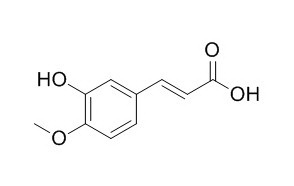3-Hydroxy-4-methoxycinnamic acid
3-Hydroxy-4-methoxycinnamic acid shows anti-inflammatory, antiviral, antioxidant, and antidiabetic properties, it is an anti-glycation agent, inhibits fructose- and glucose-mediated protein glycation.
Inquire / Order:
manager@chemfaces.com
Technical Inquiries:
service@chemfaces.com
Tel:
+86-27-84237783
Fax:
+86-27-84254680
Address:
1 Building, No. 83, CheCheng Rd., Wuhan Economic and Technological Development Zone, Wuhan, Hubei 430056, PRC
Providing storage is as stated on the product vial and the vial is kept tightly sealed, the product can be stored for up to
24 months(2-8C).
Wherever possible, you should prepare and use solutions on the same day. However, if you need to make up stock solutions in advance, we recommend that you store the solution as aliquots in tightly sealed vials at -20C. Generally, these will be useable for up to two weeks. Before use, and prior to opening the vial we recommend that you allow your product to equilibrate to room temperature for at least 1 hour.
Need more advice on solubility, usage and handling? Please email to: service@chemfaces.com
The packaging of the product may have turned upside down during transportation, resulting in the natural compounds adhering to the neck or cap of the vial. take the vial out of its packaging and gently shake to let the compounds fall to the bottom of the vial. for liquid products, centrifuge at 200-500 RPM to gather the liquid at the bottom of the vial. try to avoid loss or contamination during handling.
Pharmacognosy Journal.2020, 12(2), p232-235.
Exp Neurobiol.2018, 27(3):200-209
Braz J Med Biol Res. 2016, 49(7)
Food Science&Tech. Res.2022, 28(2):123-132.
Cell J.2024, 26(8):496-504.
Toxicol Appl Pharmacol.2022, 434:115815.
EXCLI J.2023, 22:482-498.
Plants (Basel).2020, 9(11):1535.
JMSACL2023, 09.002
Applied Biological Chemistry 2021, 64(75)
Related and Featured Products
Anticancer Agents Med Chem. 2015;15(8):980-7.
Anticancer Candidates Derived from Natural Cinnamic Acids.[Pubmed:
25634446]
Cancer is the most dangerous disease that causes deaths all over the world. Natural products have afforded a rich source of drugs in a number of therapeutic fields including anticancer agents. Many significant drugs have been derived from natural sources by structural optimization of natural products. Cinnamic acid has gained great interest due to its antiproliferative, antioxidant, antiangiogenic and antitumorigenic potency.
METHODS AND RESULTS:
Currently, cinnamic acid and its analogs such as caffeic acid, sinapic acid, ferulic acid, and isoferulic acid(3-Hydroxy-4-methoxycinnamic acid) display various pharmacological activities, such as immunomodulation, anti-inflammation, anticancer and antioxidant. They have served as a major source of potential anticancer lead compounds.
CONCLUSIONS:
In this review, we focus on the anticancer potency of cinnamic acid derivatives and novel strategies for the design of these derivatives. We hope this review will be useful for researchers who are interested in developing anticancer agents.
Nat Prod Commun. 2011 Sep;6(9):1285-8.
Evaluation of antioxidant activity of isoferulic acid in vitro.[Pubmed:
21941899]
Isoferulic acid (3-Hydroxy-4-methoxycinnamic acid, IFA), the isomer of ferulic acid (4-hydroxy-3-methoxycinnamic acid), is a rare phenolic acid occurring in Rhizoma Cimicifugae. Unlike ferulic acid, which has been well investigated, the antioxidant activity of 3-Hydroxy-4-methoxycinnamic acid has not been measured.
METHODS AND RESULTS:
In this study, 3-Hydroxy-4-methoxycinnamic acid was systematically evaluated for its in vitro antioxidant activity for the first time. IC50 values were calculated of 7.30 +/- 0.57, 4.58 +/- 0.17, 1.08 +/- 0.01, 8.84 +/- 0.43, 7.69 +/- 0.39, 1.57 +/- 0.2, 13.33 +/- 0.49 microg/mL, respectively, for lipid peroxidation, DPPH (1,1-diphenyl-2-picrylhydrazyl radical) and ABTS (3-ethylbenzthiazoline-6-sulfonic acid diammonium salt) radical scavenging, reducing power on Fe3+ and CU2+ ions, and hydroxyl and superoxide anion radical scavenging.
CONCLUSIONS:
Comparison with the IC50 values with those of the positive controls, Trolox and butylated hydroxyanisole (BHA), it can be concluded that 3-Hydroxy-4-methoxycinnamic acid is an effective natural antioxidant in both lipid and aqueous media.
Modern Food Science & Technology, 2015, 31(4):192-6.
Kinetics governing the inhibitory effect of 3-hydroxy-4-methoxycinnamic acid on tyrosinase-catalyzed reactions[Reference:
WebLink]
METHODS AND RESULTS:
The kinetics governing the inhibitory effect of 3-Hydroxy-4-methoxycinnamic acid on the activities of monophenolase and diphenolase in tyrosinase were studied using an enzymological kinetic analysis method, in a Na2HPO4-NaH2PO4 buffer system (pH=6.8) at 30℃. The 3-Hydroxy-4-methoxycinnamic acid was observed to efficiently inhibit tyrosinase monophenolase and diphenolase activities. Approximately 0.13 mmol/L and 0.39 mmol/L 3-Hydroxy-4-methoxycinnamic acid caused a 50% rate inhibition (IC50) in monophenolase and diphenolase activities, respectively; these values were much lower than that of arbutin (IC50=5.3 mmol/L for diphenolase activity). The presence of 3-Hydroxy-4-methoxycinnamic acid also prolonged the lag period of monophenolase; the presence of 0.20 mmol/L 3-Hydroxy-4-methoxycinnamic acid resulted in a lag period of 4.3 min, compared to the 1.1 min lag period of monophenolase in the absence of 3-Hydroxy-4-methoxycinnamic acid. The inhibition of diphenolase by 3-Hydroxy-4-methoxycinnamic acid appeared to be reversible.
CONCLUSIONS:
This indicated that the inhibitor suppresses the enzyme activity, resulting in a reduction in catalysis efficiency, as opposed to removing the effective enzyme, which leads to a reduction in enzyme activity. The Lineweaver-Burk plot demonstrated the competitive inhibition of tyrosinase by 3-Hydroxy-4-methoxycinnamic acid, with a maximum reaction rate (vm) and inhibition constant (KI) of 64.5 μmol/min and 0.11 mmol/L, respectively.



